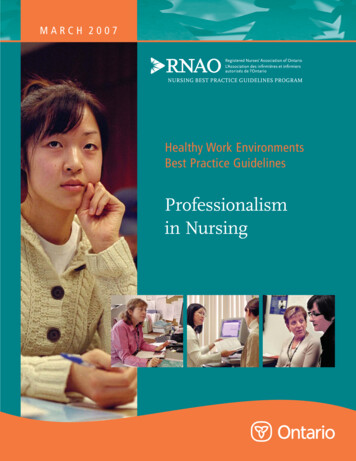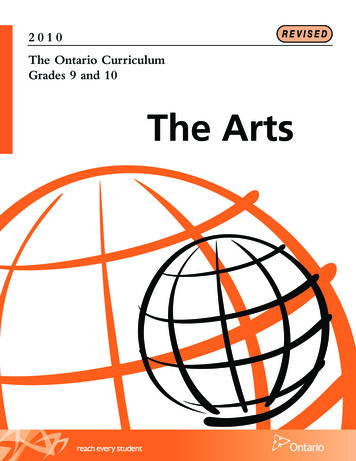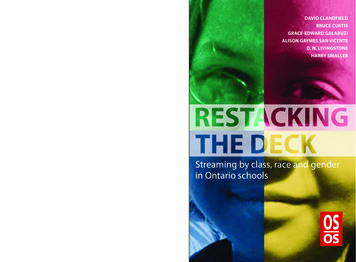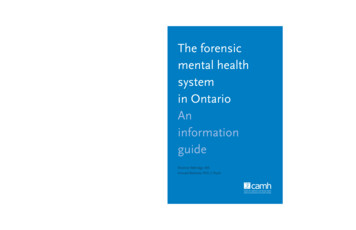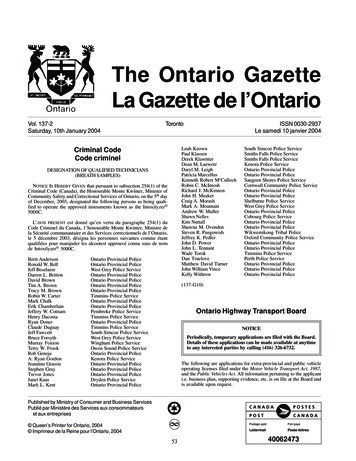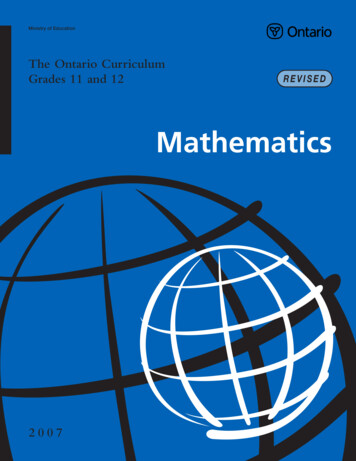
Transcription
Ministry of EducationThe Ontario CurriculumGrades 11 and 12REVISEDMathematics2007
CONTENTSINTRODUCTION3Secondary Schools for the Twenty-first Century . . . . . . . . . . . . . . . . . . . . . . . . . . . . . . . . . . . . . . . . . . . . 3The Importance of Mathematics in the Curriculum . . . . . . . . . . . . . . . . . . . . . . . . . . . . . . . . . . . . . . . . 3Roles and Responsibilities in Mathematics Programs . . . . . . . . . . . . . . . . . . . . . . . . . . . . . . . . . . . . . . 5THE PROGRAM IN MATHEMATICS7Overview of the Program . . . . . . . . . . . . . . . . . . . . . . . . . . . . . . . . . . . . . . . . . . . . . . . . . . . . . . . . . . . . . . . . . . . . . . . . 7Curriculum Expectations . . . . . . . . . . . . . . . . . . . . . . . . . . . . . . . . . . . . . . . . . . . . . . . . . . . . . . . . . . . . . . . . . . . . . . . 11Courses and Strands . . . . . . . . . . . . . . . . . . . . . . . . . . . . . . . . . . . . . . . . . . . . . . . . . . . . . . . . . . . . . . . . . . . . . . . . . . . . . 12THE MATHEMATICAL PROCESSES17Problem Solving . . . . . . . . . . . . . . . . . . . . . . . . . . . . . . . . . . . . . . . . . . . . . . . . . . . . . . . . . . . . . . . . . . . . . . . . . . . . . . . . . . 18Reasoning and Proving . . . . . . . . . . . . . . . . . . . . . . . . . . . . . . . . . . . . . . . . . . . . . . . . . . . . . . . . . . . . . . . . . . . . . . . . . 19Reflecting . . . . . . . . . . . . . . . . . . . . . . . . . . . . . . . . . . . . . . . . . . . . . . . . . . . . . . . . . . . . . . . . . . . . . . . . . . . . . . . . . . . . . . . . . . 19Selecting Tools and Computational Strategies . . . . . . . . . . . . . . . . . . . . . . . . . . . . . . . . . . . . . . . . . . . . 19Connecting . . . . . . . . . . . . . . . . . . . . . . . . . . . . . . . . . . . . . . . . . . . . . . . . . . . . . . . . . . . . . . . . . . . . . . . . . . . . . . . . . . . . . . . . 21Representing . . . . . . . . . . . . . . . . . . . . . . . . . . . . . . . . . . . . . . . . . . . . . . . . . . . . . . . . . . . . . . . . . . . . . . . . . . . . . . . . . . . . . . 21Communicating . . . . . . . . . . . . . . . . . . . . . . . . . . . . . . . . . . . . . . . . . . . . . . . . . . . . . . . . . . . . . . . . . . . . . . . . . . . . . . . . . . 22ASSESSMENT AND EVALUATION OFSTUDENT ACHIEVEMENT23Basic Considerations . . . . . . . . . . . . . . . . . . . . . . . . . . . . . . . . . . . . . . . . . . . . . . . . . . . . . . . . . . . . . . . . . . . . . . . . . . . . 23The Achievement Chart for Mathematics . . . . . . . . . . . . . . . . . . . . . . . . . . . . . . . . . . . . . . . . . . . . . . . . . . . 25Evaluation and Reporting of Student Achievement . . . . . . . . . . . . . . . . . . . . . . . . . . . . . . . . . . . . . . 26Reporting on Demonstrated Learning Skills . . . . . . . . . . . . . . . . . . . . . . . . . . . . . . . . . . . . . . . . . . . . . . . 27SOME CONSIDERATIONS FORPROGRAM PLANNING IN MATHEMATICS30Instructional Approaches . . . . . . . . . . . . . . . . . . . . . . . . . . . . . . . . . . . . . . . . . . . . . . . . . . . . . . . . . . . . . . . . . . . . . . . 30Planning Mathematics Programs for Students WithSpecial Education Needs . . . . . . . . . . . . . . . . . . . . . . . . . . . . . . . . . . . . . . . . . . . . . . . . . . . . . . . . . . . . . . . . . . . . 32Program Considerations for English Language Learners . . . . . . . . . . . . . . . . . . . . . . . . . . . . . . . . 34Une publication équivalente est disponible en français sous le titre suivant :Le curriculum de l’Ontario, 11e et 12e année – Mathématiques, 2007.This publication is available on the Ministry of Education’swebsite, at www.edu.gov.on.ca.
Antidiscrimination Education in Mathematics . . . . . . . . . . . . . . . . . . . . . . . . . . . . . . . . . . . . . . . . . . . . . 35Literacy and Inquiry/Research Skills . . . . . . . . . . . . . . . . . . . . . . . . . . . . . . . . . . . . . . . . . . . . . . . . . . . . . . . . . 36The Role of Information and Communication Technologyin Mathematics . . . . . . . . . . . . . . . . . . . . . . . . . . . . . . . . . . . . . . . . . . . . . . . . . . . . . . . . . . . . . . . . . . . . . . . . . . . . . . . . 37Career Education in Mathematics . . . . . . . . . . . . . . . . . . . . . . . . . . . . . . . . . . . . . . . . . . . . . . . . . . . . . . . . . . . 37The Ontario Skills Passport and Essential Skills . . . . . . . . . . . . . . . . . . . . . . . . . . . . . . . . . . . . . . . . . . . 38Cooperative Education and Other Forms of Experiential Learning . . . . . . . . . . . . . . . . . . . 38Planning Program Pathways and Programs Leading to aSpecialist High-Skills Major . . . . . . . . . . . . . . . . . . . . . . . . . . . . . . . . . . . . . . . . . . . . . . . . . . . . . . . . . . . . . . . . 39Health and Safety in Mathematics . . . . . . . . . . . . . . . . . . . . . . . . . . . . . . . . . . . . . . . . . . . . . . . . . . . . . . . . . . . .39COURSES41Grade 11Functions, University Preparation (MCR3U) . . . . . . . . . . . . . . . . . . . . . . . . . . . . . . . . . . . . . . . . . . . . . . . . 43Functions and Applications, University/College Preparation (MCF3M) . . . . . . . . . . . . . . 57Foundations for College Mathematics, College Preparation (MBF3C) . . . . . . . . . . . . . . . 67Mathematics for Work and Everyday Life, Workplace Preparation (MEL3E) . . . . . . . . . 77Grade 12Advanced Functions, University Preparation (MHF4U) . . . . . . . . . . . . . . . . . . . . . . . . . . . . . . . . . . 85Calculus and Vectors, University Preparation (MCV4U) . . . . . . . . . . . . . . . . . . . . . . . . . . . . . . . . . . 99Mathematics of Data Management, University Preparation (MDM4U) . . . . . . . . . . . . 111Mathematics for College Technology, College Preparation (MCT4C) . . . . . . . . . . . . . . . 123Foundations for College Mathematics, College Preparation (MAP4C) . . . . . . . . . . . . . . 135Mathematics for Work and Everyday Life, Workplace Preparation (MEL4E) . . . . . . . 147
INTRODUCTIONThis document replaces The Ontario Curriculum, Grade 11: Mathematics, 2006, and theGrade 12 courses in The Ontario Curriculum, Grades 11 and 12: Mathematics, 2000.Beginning in September 2007, all Grade 11 and Grade 12 mathematics courses will bebased on the expectations outlined in this document.SECONDARY SCHOOLS FOR THE TWENTY-FIRST CENTURYThe goal of Ontario secondary schools is to support high-quality learning while givingindividual students the opportunity to choose programs that suit their skills and interests.The updated Ontario curriculum, in combination with a broader range of learningoptions outside traditional classroom instruction, will enable students to better customizetheir high school education and improve their prospects for success in school and in life.THE IMPORTANCE OF MATHEMATICS IN THE CURRICULUMThis document provides a framework outlining what students are expected to know andbe able to do by the end of each of the courses in the Grade 11–12 mathematics curriculum.The required knowledge and skills include not only important mathematical facts andprocedures but also the mathematical concepts students need to understand and themathematical processes they must learn to apply.The principles underlying this curriculum are shared by educators dedicated to the successof all students in learning mathematics. Those principles can be stated as follows:1Curriculum expectations must be coherent, focused, and well-articulated acrossthe grades.Learning mathematics involves the meaningful acquisition of concepts, skills, andprocesses and the active involvement of students in building new knowledge fromprior knowledge and experience.Learning tools such as manipulatives and technologies are important supports forteaching and learning mathematics.Effective teaching of mathematics requires that the teacher understand the mathematical concepts, procedures, and processes that students need to learn, and use avariety of instructional strategies to support meaningful learning.Assessment and evaluation must support learning, recognizing that students learnand demonstrate learning in various ways.1. Adapted from Principles and Standards for School Mathematics, developed by the National Council of Teachers ofMathematics (Reston, VA: NCTM, 2000).
Equity of opportunity for student success in mathematics involves meeting thediverse learning needs of students and promoting excellence for all students.Equity is achieved when curriculum expectations are grade- and destinationappropriate, when teaching and learning strategies meet a broad range of studentneeds, and when a variety of pathways through the mathematics curriculum aremade available to students.The Ontario mathematics curriculum must serve a number of purposes. It must engageall students in mathematics and equip them to thrive in a society where mathematics isincreasingly relevant in the workplace. It must engage and motivate as broad a group ofstudents as possible, because early abandonment of the study of mathematics cutsstudents off from many career paths and postsecondary options.The unprecedented changes that are taking place in today’s world will profoundly affectthe future of today’s students. To meet the demands of the world in which they live, students will need to adapt to changing conditions and to learn independently. They willrequire the ability to use technology effectively and the skills for processing large amountsof quantitative information. Today’s mathematics curriculum must prepare students fortheir future roles in society. It must equip them with an understanding of importantmathematical ideas; essential mathematical knowledge and skills; skills of reasoning,problem solving, and communication; and, most importantly, the ability and the incentive to continue learning on their own. This curriculum provides a framework foraccomplishing these goals.THE ONTARIO CURRICULUM, GRADES 11 AND 12 MathematicsThe development of mathematical knowledge is a gradual process. A coherent and continuous program is necessary to help students see the “big pictures”, or underlying principles, of mathematics. The fundamentals of important skills, concepts, processes, andattitudes are initiated in the primary grades and fostered throughout elementary school.The links between Grade 8 and Grade 9 and the transition from elementary school mathematics to secondary school mathematics are very important in developing the student’sconfidence and competence.4The secondary courses are based on principles that are consistent with those that underpin the elementary program, facilitating the transition from elementary school. Thesecourses reflect the belief that students learn mathematics effectively when they are givenopportunities to investigate new ideas and concepts, make connections between newlearning and prior knowledge, and develop an understanding of the abstract mathematicsinvolved. Skill acquisition is an important part of the learning; skills are embeddedin the contexts offered by various topics in the mathematics program and should beintroduced as they are needed. The mathematics courses in this curriculum recognize theimportance of not only focusing on content, but also of developing the thinking processesthat underlie mathematics. By studying mathematics, students learn how to reason logically, think critically, and solve problems – key skills for success in today’s workplaces.Mathematical knowledge becomes meaningful and powerful in application. This curriculum embeds the learning of mathematics in the solving of problems based on real-lifesituations. Other disciplines are a ready source of effective contexts for the study of mathematics. Rich problem-solving situations can be drawn from related disciplines, such ascomputer science, business, recreation, tourism, biology, physics, and technology, as wellas from subjects historically thought of as distant from mathematics, such as geography
and art. It is important that these links between disciplines be carefully explored, analysed,and discussed to emphasize for students the pervasiveness of mathematical concepts andmathematical thinking in all subject areas.The choice of specific concepts and skills to be taught must take into consideration newapplications and new ways of doing mathematics. The development of sophisticated yeteasy-to-use calculators and computers is changing the role of procedure and technique inmathematics. Operations that were an essential part of a procedures-focused curriculumfor decades can now be accomplished quickly and effectively using technology, so thatstudents can now solve problems that were previously too time-consuming to attempt,and can focus on underlying concepts. “In an effective mathematics program, studentslearn in the presence of technology. Technology should influence the mathematics contenttaught and how it is taught. Powerful assistive and enabling computer and handheldtechnologies should be used seamlessly in teaching, learning, and assessment.”2 Thiscurriculum integrates appropriate technologies into the learning and doing of mathematics, while recognizing the continuing importance of students’ mastering essentialnumeric and algebraic skills.ROLES AND RESPONSIBILITIES IN MATHEMATICS PROGRAMSStudentsStudents have many responsibilities with regard to their learning. Students who makethe effort required to succeed in school and who are able to apply themselves will soondiscover that there is a direct relationship between this effort and their achievement, andwill therefore be more motivated to work. There will be some students, however, whowill find it more difficult to take responsibility for their learning because of special challenges they face. The attention, patience, and encouragement of teachers and family canbe extremely important to these students’ success. However, taking responsibility fortheir own progress and learning is an important part of education for all students,regardless of their circumstances.Mastery of concepts and skills in mathematics requires a sincere commitment to workand study. Students are expected to develop strategies and processes that facilitate learning and understanding in mathematics. Students should also be encouraged to activelypursue opportunities to apply their problem-solving skills outside the classroom and toextend and enrich their understanding of mathematics.ParentsParents3 have an important role to play in supporting student learning. Studies show thatstudents perform better in school if their parents are involved in their education. Bybecoming familiar with the curriculum, parents can find out what is being taught in thecourses their children are taking and what their children are expected to learn. Thisawareness will enhance parents’ ability to discuss their children’s work with them, tocommunicate with teachers, and to ask relevant questions about their children’s progress.INTRODUCTION2. Expert Panel on Student Success in Ontario, Leading Math Success: Mathematical Literacy, Grades 7–12 – The Report ofthe Expert Panel on Student Success in Ontario, 2004 (Toronto: Ontario Ministry of Education, 2004), p. 47. (Referred tohereafter as Leading Math Success.)3. The word parents is used throughout this document to stand for parent(s) and guardian(s).5
Knowledge of the expectations in the various courses also helps parents to interpretteachers’ comments on student progress and to work with them to improve studentlearning.Effective ways for parents to support their children’s learning include attending parentteacher interviews, participating in parent workshops, becoming involved in school councilactivities (including becoming a school council member), and encouraging their childrento complete their assignments at home.The mathematics curriculum promotes lifelong learning. In addition to supporting regular school activities, parents can encourage their children to apply their problem-solvingskills to other disciplines and to real-world situations.TeachersTeachers and students have complementary responsibilities. Teachers are responsible fordeveloping appropriate instructional strategies to help students achieve the curriculumexpectations for their courses, as well as for developing appropriate methods for assessing and evaluating student learning. Teachers also support students in developing thereading, writing, and oral communication skills needed for success in their mathematicscourses. Teachers bring enthusiasm and varied teaching and assessment approaches tothe classroom, addressing different student needs and ensuring sound learning opportunities for every student.THE ONTARIO CURRICULUM, GRADES 11 AND 12 MathematicsRecognizing that students need a solid conceptual foundation in mathematics in order tofurther develop and apply their knowledge effectively, teachers endeavour to create aclassroom environment that engages students’ interest and helps them arrive at theunderstanding of mathematics that is critical to further learning.6Using a variety of instructional, assessment, and evaluation strategies, teachers providenumerous opportunities for students to develop skills of inquiry, problem solving, andcommunication as they investigate and learn fundamental concepts. The activities offeredshould enable students not only to make connections among these concepts throughoutthe course but also to relate and apply them to relevant societal, environmental, andeconomic contexts. Opportunities to relate knowledge and skills to these wider contexts –to the goals and concerns of the world in which they live – will motivate students to learnand to become lifelong learners.PrincipalsThe principal works in partnership with teachers and parents to ensure that each studenthas access to the best possible educational experience. To support student learning, principals ensure that the Ontario curriculum is being properly implemented in all classroomsthrough the use of a variety of instructional approaches. They also ensure that appropriateresources are made available for teachers and students. To enhance teaching and learningin all subjects, including mathematics, principals promote learning teams and work withteachers to facilitate participation in professional-development activities.Principals are also responsible for ensuring that every student who has an IndividualEducation Plan (IEP) is receiving the modifications and/or accommodations describedin his or her plan – in other words, for ensuring that the IEP is properly developed,implemented, and monitored.
THE PROGRAM INMATHEMATICSOVERVIEW OF THE PROGRAMThe senior mathematics courses build on the Grade 9 and 10 program, relying on thesame fundamental principles on which that program was based. Both are founded on thepremise that students learn mathematics most effectively when they build a thoroughunderstanding of mathematical concepts and procedures. Such understanding is achievedwhen mathematical concepts and procedures are introduced through an investigativeapproach and connected to students’ prior knowledge in meaningful ways. This curriculum is designed to help students prepare for university, college, or the workplace bybuilding a solid conceptual foundation in mathematics that will enable them to applytheir knowledge and skills in a variety of ways and further their learning successfully.An important part of every course in the mathematics program is the process of inquiry,in which students develop methods for exploring new problems or unfamiliar situations.Knowing how to learn mathematics is the underlying expectation that every student inevery course needs to achieve. An important part of the inquiry process is that of takingthe conditions of a real-world situation and representing them in mathematical form. Amathematical representation can take many different forms – for example, it can be aphysical model, a diagram, a graph, a table of values, an equation, or a computer simulation. It is important that students recognize various mathematical representations ofgiven relationships and that they become familiar with increasingly sophisticated representations as they progress through secondary school.The prevalence in today’s society and classrooms of sophisticated yet easy-to-use calculators and computer software accounts in part for the inclusion of certain concepts andskills in this curriculum. The curriculum has been designed to integrate appropriatetechnologies into the learning and doing of mathematics, while equipping students withthe manipulation skills necessary to understand other aspects of the mathematics thatthey are learning, to solve meaningful problems, and to continue to learn mathematicswith success in the future. Technology is not used to replace skill acquisition; rather, itis treated as a learning tool that helps students explore concepts. Technology is requiredwhen its use represents either the only way or the most effective way to achieve anexpectation.Like the earlier curriculum experienced by students, the senior secondary curriculumadopts a strong focus on the processes that best enable students to understand mathematical concepts and learn related skills. Attention to the mathematical processes is
considered to be essential to a balanced mathematics program. The seven mathematicalprocesses identified in this curriculum are problem solving, reasoning and proving, reflecting,selecting tools and computational strategies, connecting, representing, and communicating.Each of the senior mathematics courses includes a set of expectations – referred to in thisdocument as the “mathematical process expectations” – that outline the knowledge andskills involved in these essential processes. The mathematical processes apply to studentlearning in all areas of a mathematics course.A balanced mathematics program at the secondary level also includes the development ofalgebraic skills. This curriculum has been designed to equip students with the algebraicskills needed to solve meaningful problems, to understand the mathematical conceptsthey are learning, and to successfully continue their study of mathematics in the future.The algebraic skills required in each course have been carefully chosen to support thetopics included in the course. Calculators and other appropriate technologies will be usedwhen the primary purpose of a given activity is the development of concepts or the solving of problems, or when situations arise in which computation or symbolic manipulationis of secondary importance.Courses in Grade 11 and Grade 12Four types of courses are offered in the senior mathematics program: university preparation, university/college preparation, college preparation, and workplace preparation. Studentschoose course types on the basis of their interests, achievement, and postsecondary goals.The course types are defined as follows:University preparation courses are designed to equip students with the knowledge andskills they need to meet the entrance requirements for university programs.University/college preparation courses are designed to equip students with the knowledgeand skills they need to meet the entrance requirements for specific programs offered atuniversities and colleges.THE ONTARIO CURRICULUM, GRADES 11 AND 12 MathematicsCollege preparation courses are designed to equip students with the knowledge andskills they need to meet the requirements for entrance to most college programs or foradmission to specific apprenticeship or other training programs.8Workplace preparation courses are designed to equip students with the knowledge andskills they need to meet the expectations of employers, if they plan to enter the workplacedirectly after graduation, or the requirements for admission to many apprenticeship orother training programs.
Courses in Mathematics, Grades 11 and 12GradeCourse NameCourse TypeCourse CodePrerequisite11FunctionsUniversityMCR3UGrade 10 Principles of Mathematics, Academic11Functions andApplicationsUniversity/CollegeMCF3MGrade 10 Principles of Mathematics, Academic,or Grade 10 Foundations of Mathematics, Applied11Foundationsfor CollegeMathematicsCollegeMBF3CGrade 10 Foundations of Mathematics, AppliedMathematics11Mathematicsfor Work andEveryday LifeWorkplaceMEL3EGrade 9 Principles of Mathematics, Academic, orGrade 9 Foundations of Mathematics, Applied, ora Grade 10 Mathematics LDCC (locally developedcompulsory credit) course12AdvancedFunctionsUniversityMHF4UGrade 11 Functions, University12Calculusand VectorsUniversityMCV4UGrade 12 Advanced Functions, University, must betaken prior to or concurrently with Calculus andVectors.12Mathematicsof DataManagementUniversityMDM4UGrade 11 Functions, University, or Grade 11Functions and Applications, University/College12Mathematicsfor CollegeTechnologyCollegeMCT4CGrade 11 Functions and Applications,University/College, or Grade 11 Functions,University12Foundationsfor CollegeMathematicsCollegeMAP4CGrade 11 Foundations for CollegeMathematics, College, or Grade 11 Functionsand Applications, University/College12Mathematicsfor Work andEveryday LifeWorkplaceMEL4EGrade 11 Mathematics for Work and EverydayLife, WorkplaceNote: Each of the courses listed above is worth one credit.THE PROGRAM IN MATHEMATICS9
Prerequisite Chart for Mathematics, Grades 9–12This chart maps out all the courses in the discipline and shows the links between courses and the possibleprerequisites for them. It does not attempt to depict all possible movements from course to course.Calculus andVectorsMCV4UGrade 12UniversityNote: Advanced Functions (MHF4U) mustbe taken prior to or concurrently withCalculus and Vectors (MCV4U).AdvancedFunctionsMHF4UGrade 12UniversityFunctionsMCR3UPrinciplesof MathematicsMPM1DPrinciplesof MathematicsMPM2DGrade 9AcademicGrade 10AcademicTHE ONTARIO CURRICULUM, GRADES 11 AND 12 MathematicsT10Foundationsof MathematicsMFM1PFoundationsof MathematicsMFM2PGrade 9AppliedGrade 10AppliedMathematicsLDCCMathematicsGrade 9Grade 10LDCCMathematics ofData ManagementMDM4UGrade 11UniversityGrade 12UniversityFunctions andApplicationsMCF3MMathematics forCollege TechnologyMCT4CGrade 11University/CollegeGrade 12CollegeFoundations forCollegeMathematicsMBF3CFoundations forCollegeMathematicsMAP4CGrade 11CollegeGrade 12CollegeMathematics forWork and EverydayLifeMEL3EMathematics forWork and EverydayLifeMEL4EGrade 11WorkplaceGrade 12WorkplaceNotes: T – transfer course LDCC – locally developed compulsory credit course (LDCC courses are not outlined in this document.)
Half-Credit CoursesThe courses outlined in this document are designed to be offered as full-credit courses.However, with the exception of the Grade 12 university preparation courses, they may also bedelivered as half-credit courses.Half-credit courses, which require a minimum of fifty-five hours of scheduled instructional time, must adhere to the following conditions:The two half-credit courses created from a full course must together contain allof the expectations of the full course. The expectations for each half-credit coursemust be divided in a manner that best enables students to achieve the requiredknowledge and skills in the allotted time.A course that is a prerequisite for another course in the secondary curriculum maybe offered as two half-credit courses, but students must successfully complete bothparts of the course to fulfil the prerequisite. (Students are not required to completeboth parts unless the course is a prerequisite for another course they wish to take.)The title of each half-credit course must include the designation Part 1 or Part 2.A half credit (0.5) will be recorded in the credit-value column of both the reportcard and the Ontario Student Transcript.Boards will ensure that all half-credit courses comply with the conditions described above,and will report all half-credit courses to the ministry annually in the School OctoberReport.CURRICULUM EXPECTATIONSThe expectations identified for each course describe the knowledge and skills that students are expected to acquire, demonstrate, and apply in their class work, on tests, and invarious other activities on which their achievement is assessed and evaluated.Two sets of expectations are listed for each strand, or broad curriculum area, of each course.The overall expectations describe in general terms the knowledge and skills that students are expected to demonstrate by the end of each course.In addition to the expectations outlined within each strand, a list of seven “mathematicalprocess expectations” precedes the strands in all mathematics courses. These specificexpectations describe the knowledge and skills that constitute processes essential to theeffective study of mathematics. These processes apply to all areas of course content, andTHE PROGRAM IN MATHEMATICSThe specific expectations describe the expected knowledge and skills in greaterdetail. The specific expectations are arranged under numbered subheadings thatrelate to the overall expectations and that may serve as a guide for teachers as theyplan learning activities for their students. The specific expectations are also numbered to indicate the overall expectation to which they relate (e.g., specific expectation 3.2 is related to overall expectation 3 in a given strand). The organization ofexpectations in subgroupings is not meant to imply that the expectations in anysubgroup are achieved independently of the expectations in the other subgroups.The subheadings are used merely to help teachers focus on particular aspects ofknowledge and skills as they develop and use various lessons and learning activities with their students.11
students’ proficiency in applying them must be developed in all strands of a mathematicscourse. Teachers should ensure that students develop their ability to apply these processesin appropriate ways as they work towards
in the contexts offered by various topics in the mathematics program and should be introduced as they are needed. The mathematics courses in this curriculum recognize the importance of not only focusing on content, but also of developing the thinking processes that underlie mathematics. By studying mathematics, students learn how to reason logi-


